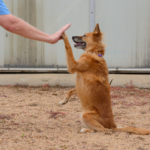If you’ve noticed your furry friend behaving differently or showing signs of anxiety, understanding common behavioral disorders in dogs can help you find the right support for their well-being.
Dogs can experience various types of anxiety or behavioral issues, but there’s good news – veterinary behaviorists and licensed dog trainers are here to help! They can work with you to create customized treatment plans that may include behavior modification strategies and, in some cases, medications. Some FDA-approved medications for dog anxiety include Fluoxetine and Sileo, but other off-label human medications can also be used. These medications can be compounded into different forms for easier administration, and among the most frequently prescribed ones are Alprazolam, Amitriptyline, Buspirone, Clomipramine, Dexmedetomidine, Diazepam, Fluoxetine, Lorazepam, Paroxetine, and Sertraline. Let’s explore further together to ensure your canine companion gains the happy and balanced life they deserve.

Types of Behavioral Disorders in Dogs
Anxiety disorders
Anxiety disorders in dogs can manifest in various ways, including generalized anxiety, separation anxiety, and specific phobias. Dogs with anxiety disorders may exhibit excessive fear or worry in response to certain stimuli or situations. They may show signs of restlessness, excessive panting, pacing, trembling or shaking, excessive drooling, or excessive grooming or licking.
Aggression
Aggression is another common behavioral disorder in dogs. It can be directed towards humans or other animals and may occur in response to fear, territoriality, or frustration. Aggressive behaviors in dogs can include growling, snarling, snapping, biting, or lunging.
Phobias
Phobias in dogs are intense and irrational fears of specific objects, situations, or stimuli. Common phobias in dogs include thunderstorm phobia, noise phobia, and phobia of certain objects or places. Dogs with phobias may exhibit extreme fear responses, such as hiding, shaking, panting, pacing, or attempting to escape.
Compulsive behaviors
Compulsive behaviors in dogs are repetitive and purposeless actions that are performed excessively. These behaviors may include excessive licking, pacing, tail-chasing, or flank-sucking. Compulsive behaviors can be a result of underlying anxiety or obsessive-compulsive disorder.
Separation anxiety
Separation anxiety is a specific form of anxiety disorder in dogs. Dogs with separation anxiety become excessively distressed when left alone or separated from their owners. They may engage in destructive behaviors, excessive barking or howling, or exhibit signs of distress such as panting, pacing, or drooling.
Obsessive-compulsive disorder
Obsessive-compulsive disorder (OCD) in dogs is characterized by repetitive actions or behaviors that serve no purpose. These behaviors may include excessive tail-chasing, shadow-chasing, or paw-licking. Dogs with OCD may also exhibit anxiety-related symptoms.
Fearful behaviors
Fearful behaviors in dogs can range from mild timidity to extreme fear or phobia. Dogs that are fearful may show signs of avoidance, trembling, hiding, or aggression. Fearful behaviors can be a result of traumatic experiences, lack of socialization, or genetics.
Destructive behaviors
Destructive behaviors in dogs can include chewing or damaging objects, digging, scratching, or tearing furniture or other items. Dogs may engage in destructive behaviors out of boredom, anxiety, or frustration. It is important to address and redirect these behaviors to prevent damage and keep the dog safe.
Excessive barking
Excessive barking is a common behavioral problem in dogs. Dogs may bark excessively to communicate, seek attention, express fear or anxiety, or in response to specific triggers. Excessive barking can disturb the peace, cause nuisance to neighbors, and indicate underlying behavioral issues that need to be addressed.
House soiling
House soiling, or inappropriate elimination, refers to dogs urinating or defecating indoors, typically outside of designated areas such as litter boxes or outdoor spaces. It can be a result of various behavioral or medical issues, including anxiety, fear, lack of house training, or medical conditions.
Symptoms of Behavioral Disorders in Dogs
Restlessness
Restlessness is often observed in dogs with behavioral disorders. They may exhibit an inability to settle, constantly shifting positions, and restlessness during sleep or relaxation.
Excessive panting
Excessive panting is a common symptom of anxiety or fear in dogs. Dogs experiencing anxiety or stress may pant excessively, even when they are not physically exerting themselves or in a warm environment.
Pacing
Pacing is a repetitive behavior characterized by the dog continuously walking back and forth in a restricted area. Dogs may pace due to stress, anxiety, or boredom.
Trembling or shaking
Trembling or shaking is a physical manifestation of fear, anxiety, or stress in dogs. It can be observed during specific triggers or situations that cause the dog distress.
Excessive drooling
Excessive drooling, also known as hypersalivation, can occur in dogs with anxiety or fear. Dogs may drool excessively in response to stressful situations, anticipation of certain events, or when experiencing discomfort or pain.
Excessive grooming or licking
Dogs with behavioral disorders may engage in excessive grooming or licking behaviors as a coping mechanism or self-soothing behavior. They may focus on specific body parts or objects, leading to skin irritation or hair loss.
Aggressive behavior
Aggressive behavior can be a symptom of underlying behavioral disorders in dogs. It may manifest as growling, snarling, snapping, biting, or lunging towards humans or other animals.
Fearful behavior
Fearful behavior is characterized by a dog’s extreme apprehension or fright when faced with certain triggers or situations. Dogs may exhibit avoidance, trembling, cowering, or hiding in response to fear.
Compulsive behaviors
Repetitive and purposeless actions, known as compulsive behaviors, can be indicative of underlying anxiety or obsessive-compulsive disorder in dogs. These behaviors may include excessive licking, pacing, tail-chasing, or flank-sucking.
Excessive barking
Excessive barking is a symptom of various behavioral disorders in dogs, such as anxiety, fear, or territoriality. Dogs may bark excessively in response to specific triggers or to seek attention or relief from stress or anxiety.
Causes of Behavioral Disorders in Dogs
Genetics
Genetics plays a role in the development of behavioral disorders in dogs. Some breeds may be more predisposed to certain types of behaviors, such as anxiety or aggression. However, environmental factors and early socialization also significantly influence a dog’s behavior.
Poor socialization
Lack of proper socialization during a dog’s critical developmental period can contribute to the development of behavioral disorders. Dogs that have not been exposed to a variety of people, animals, and environments may be more prone to fear, anxiety, and aggression.
Traumatic experiences
Traumatic experiences, such as abuse, neglect, or a traumatic event, can have long-lasting effects on a dog’s behavior. These experiences may lead to fearfulness, anxiety, or aggressive behaviors.
Medical conditions
Some medical conditions can manifest as behavioral disorders in dogs. Pain, hormonal imbalances, neurological disorders, or certain diseases may contribute to changes in behavior.
Environmental factors
Environmental factors, such as a chaotic or stressful living environment, can contribute to the development of behavioral disorders in dogs. Dogs that are exposed to constant noise, conflict, or inconsistent routines may exhibit signs of anxiety or aggression.
Lack of mental stimulation
Dogs require mental stimulation to prevent boredom and promote good behavior. Lack of mental stimulation, such as inadequate exercise or mental enrichment activities, can lead to destructive behaviors or hyperactivity.

Diagnosing Behavioral Disorders in Dogs
Behavioral assessment
A comprehensive behavioral assessment can help identify and diagnose behavioral disorders in dogs. This assessment typically involves observation of the dog’s behavior, history taking, and assessment of environmental factors.
Eliminating medical causes
Before diagnosing a behavioral disorder, it is crucial to rule out any underlying medical causes that may be contributing to the observed behaviors. A thorough veterinary examination and appropriate diagnostic tests may be required.
Veterinary consultation
Consulting with a veterinarian who specializes in behavioral medicine can provide valuable insights into a dog’s behavior. They can help assess the underlying causes of the behavioral disorder and develop a tailored treatment plan.
Observation of behavior patterns
Observing a dog’s behavior patterns over a period of time can provide important information about the triggers and frequency of specific behaviors. Keeping a behavior log or video recording can assist in the diagnostic process.
Discussion with the dog’s owner
Gathering information from the dog’s owner about the dog’s behavior, temperament, and environment is essential in diagnosing behavioral disorders. The owner’s insight can provide valuable context and help identify potential triggers or contributing factors.
Treatment Options for Behavioral Disorders in Dogs
Behavior modification
Behavior modification techniques aim to change a dog’s behavior by addressing the root causes of the behavioral disorder. Positive reinforcement, desensitization and counter-conditioning, and redirecting behavior are commonly used behavior modification techniques.
Medication
In some cases, medication may be recommended as part of a comprehensive treatment plan for dogs with behavioral disorders. Medications can help manage underlying anxiety, fear, or aggression and work in conjunction with behavior modification techniques.
Training and obedience
Training and obedience classes can provide structure, socialization, and mental stimulation for dogs. Consistent training and positive reinforcement can help address behavior problems and improve overall obedience and focus.
Environmental management
Modifying the dog’s environment to reduce triggers or stressors can be important in managing behavioral disorders. This may involve creating a safe and calm space for the dog, using pheromone diffusers, or implementing structured routines.
Professional help (veterinary behaviorists or trainers)
Working with a veterinary behaviorist or a licensed dog trainer who specializes in behavior can provide professional guidance and support in treating behavioral disorders. They can develop a personalized treatment plan and provide ongoing coaching and support.
Behavior Modification Techniques
Desensitization and counter-conditioning
Desensitization and counter-conditioning involve gradually exposing the dog to the fear or anxiety-inducing stimulus in a controlled and positive way. This helps the dog develop a more positive association with the trigger and reduce fear or anxiety.
Positive reinforcement training
Positive reinforcement training focuses on rewarding desired behaviors and ignoring or redirecting unwanted behaviors. This technique helps reinforce positive behaviors and encourages the dog to repeat them while minimizing the occurrence of negative behaviors.
Cognitive-behavioral therapy
Cognitive-behavioral therapy (CBT) involves identifying and challenging negative thoughts or beliefs that contribute to a dog’s behavioral disorders. CBT techniques aim to modify the dog’s thought patterns and encourage more positive and adaptive behaviors.
Command training
Command training involves teaching the dog basic obedience commands and cues. This helps establish a clear communication system between the owner and the dog, promoting better behavior control and reducing problem behaviors.
Redirecting behavior
Redirecting behavior involves providing the dog with an alternative, incompatible behavior to replace unwanted behaviors. For example, redirecting excessive chewing onto appropriate chew toys or redirecting jumping onto sitting or lying down.
Medications for Behavioral Disorders in Dogs
Fluoxetine
Fluoxetine is an FDA-approved medication commonly used to treat behavioral disorders in dogs, including anxiety and aggression. It is a selective serotonin reuptake inhibitor (SSRI) that helps regulate abnormal serotonin levels in the brain.
Sileo
Sileo is an FDA-approved medication specifically formulated for noise aversion and anxiety in dogs. It is an oral gel that contains the active ingredient dexmedetomidine and is administered between the cheek and gum.
Alprazolam
Alprazolam is a medication that is sometimes used off-label in dogs to treat anxiety or panic disorders. It is a benzodiazepine that helps promote relaxation and reduce anxiety.
Amitriptyline
Amitriptyline is an off-label medication that is commonly used in dogs to treat separation anxiety, aggression, or compulsive behaviors. It is a tricyclic antidepressant that affects the balance of certain neurotransmitters in the brain.
Buspirone
Buspirone is an off-label medication that is used in dogs to manage anxiety, particularly generalized anxiety. It is a serotonin receptor agonist that helps reduce anxiety symptoms.
Clomipramine
Clomipramine is an off-label medication commonly used in dogs to treat separation anxiety, obsessive-compulsive disorder, or generalized anxiety. It is a tricyclic antidepressant that affects serotonin levels in the brain.
Dexmedetomidine
Dexmedetomidine is the active ingredient in Sileo, an FDA-approved medication for noise aversion and anxiety in dogs. It is a selective alpha-2 adrenergic agonist that has sedative and analgesic effects.
Diazepam
Diazepam is sometimes used off-label in dogs to manage anxiety, especially in cases of noise aversion or seizure disorders. It is a benzodiazepine that produces calming effects.
Lorazepam
Lorazepam is an off-label medication that is occasionally used in dogs to manage anxiety or fear-related behaviors. It is a benzodiazepine that has sedative and anxiolytic properties.
Paroxetine
Paroxetine is an off-label medication frequently used in dogs to treat separation anxiety, aggressive behaviors, or mood disorders. It is an SSRI that helps regulate serotonin levels in the brain.
Sertraline
Sertraline is an off-label medication commonly used in dogs to treat anxiety, separation anxiety, or compulsive behaviors. It is an SSRI that helps regulate serotonin levels in the brain.
Off-Label Medications
Use of human medications in dogs
In certain cases, veterinarians may prescribe human medications off-label to treat behavioral disorders in dogs. These medications may be used cautiously, with careful consideration of appropriate dosages and potential side effects.
Efficacy and safety considerations
When using human medications off-label in dogs, it is important to consider the efficacy and safety of the medication. The veterinarian will assess the potential benefits and risks on a case-by-case basis, taking into account the individual dog’s health and behavioral history.
Compounding Medications for Dogs
Changing medication form for easier administration
Some medications may need to be compounded into a different form to make administration easier for dogs. This may involve creating a flavored liquid, chewable treat, or transdermal gel to accommodate the dog’s preferences or medical condition.
Compounding process
Compounding medications for dogs involves altering the medication’s formulation, strength, or dosage form to meet the specific needs of the dog. This process is carried out by compounding pharmacists who have specialized knowledge in veterinary medicine.
Benefits and limitations
Compounding medications for dogs allows for individualized treatment options and improved medication compliance. However, it is important to work with a reputable compounding pharmacy to ensure medication quality and safety.
Conclusion
Behavioral disorders in dogs can significantly impact their daily lives and general well-being. Recognizing the different types of behavioral disorders, understanding their symptoms, and addressing their underlying causes is crucial for effective treatment. With the help of professionals, such as veterinary behaviorists or trainers, and the use of behavior modification techniques and medications when necessary, dogs can lead happier and more balanced lives. Remember to always consult with a veterinarian to ensure appropriate diagnosis and a tailored treatment plan for your furry companion.









